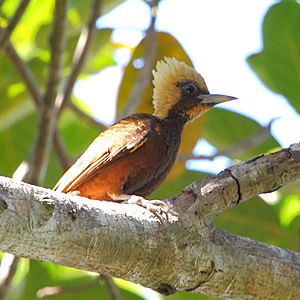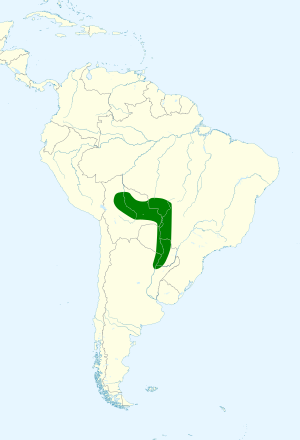Pale-crested woodpecker facts for kids
Quick facts for kids Pale-crested woodpecker |
|
|---|---|
 |
|
| Female at Poconé, Mato Grosso, Brazil | |
| Conservation status | |
| Scientific classification | |
| Genus: |
Celeus
|
| Species: |
lugubris
|
 |
|
The pale-crested woodpecker (scientific name: Celeus lugubris) is a type of bird that belongs to the woodpecker family. You can find this bird in parts of Argentina, Bolivia, Brazil, and Paraguay.
Contents
About Its Family and Names
Woodpeckers are a big family of birds! The pale-crested woodpecker is part of a group called Picinae. Scientists use special names to keep track of different animals. For this woodpecker, there are two main types, called subspecies:
- C. l. lugubris
- C. l. kerri
Sometimes, scientists discuss if C. l. kerri should be its own species. Also, some think the pale-crested woodpecker and the blond-crested woodpecker might be the same species. But for now, most agree on the two subspecies.
What It Looks Like
The pale-crested woodpecker is about 23 to 24 centimeters (9 to 9.5 inches) long. It weighs between 112 and 157 grams (about 4 to 5.5 ounces).
Here are some cool facts about its appearance:
- Males have a bright red area on their cheeks and sometimes around their eyes.
- Females have brown stripes or scales in the same areas instead of red.
- Both sexes have a pale, blond, or creamy head. This includes their long, pointed crest, chin, and throat.
- Their upper body is a deep reddish-black. Their lower back and rump are blond or cream-colored.
- Their back has thin, light brown stripes.
- Their flight feathers are dark brownish-black with reddish-brown stripes.
- Their tail feathers are black, with some reddish-brown spots on the outer ones.
- Their lower neck and belly are dark, sooty reddish-brown.
- Their bill is grayish, their eyes are dark red, and their legs are gray.
Young woodpeckers look similar to adults. However, they have some black on their heads and uneven stripes on their upper bodies. The C. l. kerri subspecies looks almost the same but is a bit larger and darker.
Where It Lives and Its Home
The pale-crested woodpecker lives in different parts of South America.
- The C. l. lugubris subspecies is found in central and eastern Bolivia. It also lives in the western part of Brazil's Mato Grosso state.
- The C. l. kerri subspecies lives in most of Paraguay. It's also found in southern Mato Grosso and the state of Mato Grosso do Sul in Brazil. You can also see it in northeastern Argentina.
These woodpeckers like open areas. They live in semi-deciduous forests, which lose some leaves in dry seasons. They also like cerrado woodlands and dry Chaco woodlands. You can often find them where there are palm trees.
How It Behaves
Staying Put
The pale-crested woodpecker does not migrate. It stays in the same area all year round.
What It Eats
This woodpecker's favorite food is ants! It eats adult ants, their larvae (baby ants), and pupae (ants in a resting stage). It usually looks for food in the middle parts of trees. It finds its prey by:
- Probing into wood.
- Gleaning (picking insects off surfaces).
- Pecking open dead wood and ant tunnels.
Reproduction and Life Cycle
The breeding season for the pale-crested woodpecker is mainly from September to November. It might breed a bit later in the southern parts of its range.
- It digs a nest hole in a tree.
- Sometimes, it uses a nest in an ant or termite mound that is attached to a tree.
- These nests are usually 4 to 10 meters (about 13 to 33 feet) above the ground.
Not much else is known about how they raise their young.
Sounds It Makes
The pale-crested woodpecker has a special song. It sounds like a very high, fluted "twee-twee-tee-tee-tee." It also drums on trees, but its drumming sound is not very strong.
How It's Doing
The IUCN (International Union for Conservation of Nature) says the pale-crested woodpecker is a species of "Least Concern." This means it's not currently in danger of disappearing.
- It lives across a large area.
- However, we don't know exactly how many of these woodpeckers there are.
- Scientists believe their numbers might be slowly going down.
- No big threats have been found right now.
- It is considered "fairly common" in many places where it lives.
- It can be found in several protected areas.
Scientists say more research is needed to learn about its life and how it raises its young.
Images for kids
See also
 In Spanish: Carpintero lúgubre para niños
In Spanish: Carpintero lúgubre para niños



